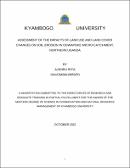| dc.description.abstract | Several land use/cover changes have been observed in Ogwapoke micro catchment. Population
increase, poverty, intensified and unsustainable farming practices and deforestation have been
cited as the major drivers of land use/cover changes in the micro catchment. Land use/cover
changes have been linked with increased surface runoff and soil erosion. However, there is a
paucity of information to ascertain the impacts of land use/cover changes on soil erosion in
Ogwapoke micro-catchment, Northern Uganda. Therefore, the study aimed to identify
conservation measures and drivers that lead to continuous changes in land use/cover in order to
combat the long-term effects of soil erosion on hydrological flow in Ogwapoke micro catchment.
Specifically, the study aimed to (i) analyze and predict the spatial-temporal changes in land
use/cover changes between 1986, 2003, 2020 and 2040 in Ogwapoke micro catchment; (ii)
determine the effect of land use/cover change on soil erosion in Ogwapoke micro catchment; and
(iii) assess the impact of land use/cover change on hydrological flow in Ogwapoke micro
catchment.
Landsat images for the study area for 1986, 2003 and 2020 were downloaded from Earth
explorer. Unsupervised classification and the CA-Markov model were used to analyze and
predict the land use/cover changes respectively. Questionnaires were also administered to 200
respondents in the study area to understand their perceptions of land use/cover changes including
the drivers. The Revised Universal Soil Loss Equation (RUSLE) and the Soil and Water
Assessment Tool (SWAT) models were used to assess the soil erosion and hydrological flow
components (total yield, base flow, surface runoff, lateral flow, deep aquifer recharge, and actual
evapotranspiration), respectively. The Pearson correlation coefficient was applied to assess the
effect of land use/cover changes on hydrological flow components.
Results showed that significant land use/cover changes have taken place in Ogwapoke micro
catchment. Between 1986 and 2020, small-scale farmlands and built-up areas increased by
35.1% and 2.4%, respectively whereas bushlands, grasslands, wetlands and woodlands decreased
by 11.7%, 7.4%, 2.4%, and 15.9% respectively. A similar pattern is projected to further intensify
by 2040. Changes in land use/cover are mostly driven by over grazing, deforestation, poverty,
bush burning, deforestation, and increased demand for food due to population growth. The
changes in land use/cover had an effect on soil erosion in Ogwapoke micro catchment. Small | en_US |

